The hull of the Royal Navy’s second Type 26 Frigate, HMS Cardiff, has now entered construction.
The frigate is being built at the BAE Systems shipyard in Govan, Glasgow and is the second to enter production as part of the £3.7 billion contract, announced by the MoD in 2017.
We are proud to announce that full scale manufacture of the second Type 26 Global Combat Ship, CARDIFF, is underway. @annietrev started the process in front of gathered employees #Type26 #CARDIFF pic.twitter.com/ojlveoDPpQ
— BAE Systems Maritime (@BAES_Maritime) August 14, 2019
A Ministry of Defence spokesman said:
“The Type 26 Frigate is a cutting-edge warship, combining the expertise of the British shipbuilding industry with the excellence of the Royal Navy. These ships will be a force to be reckoned with, there to protect our powerful new carriers and helping keep British interests safe across the world.”
BAE Systems said:
“It was a pleasure to welcome representatives of the City of Cardiff to our ceremony. The contract for the first batch of three Type 26 ships provides a solid platform to sustain our industrial skill base & ensures the Royal Navy have the ships it needs to protect UK interests.”
Eight Type 26 Frigates are to be built in total with three in the first batch, the contract for the second batch will be negotiated in the coming year. Ordering in batches is common for projects of this size around the world and was last seen with the Royal Navy for the Type 45 Destroyers and recent Offshore Patrol Vessels. The Type 45s first batch order was for three vessels for example.





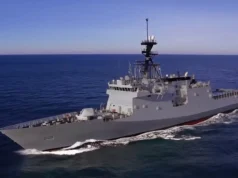
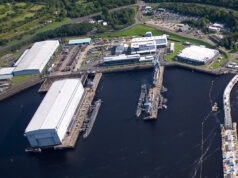
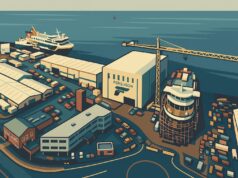
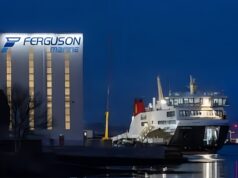
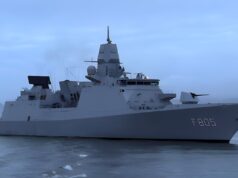

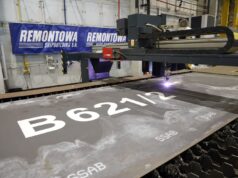
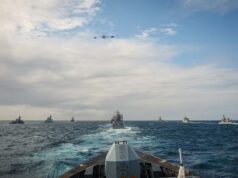

Good wish we could speed this up and have a real Frigate Factory that was knocking these out to allow numbers to actually increase.
Are there any recent pictures of HMS Glasgow available? She should be starting to look like a proper ship rather than a series of blocks, even given the leisurely pac of construction.
When is the launch date of Glasgow, I have a feeling is 2023 before it touches water.
I cant help thinking that while the T26 programme is to be admired,the build rates are so slow,when they eventually enter service they will be bordering on obsolete.
They won’t be obsolete, it’s just that we need them more quickly than David Cameron’s deliberately slow build schedule allows.
The radar especially. Im hoping the batch 2s with have the seafar 2 radar as some sort of industrial exchange for Australia buying sonar and engines from the UK.
Radar is such a critical area that I’d rather see a next-generation product arising from Artisan/Sampson to keep in-country capability. Artisan/Sampson references are not intended to indicate continued use of rotating arrays, more that we (the UK) already have some world-class back-end processing/analysis capabilities together with the technical expertise required to create them and I would prefer to see that expertise nurtured and built upon plus the quality of the existing product should give us a strong starting point to create something quite special for the next generation.
(P.S. I’m assuming you had a typo and meant CEAFAR from CEA Technologies – that’s not a dig, I bet a spellchecker probably mangled it for you, I just wanted to be sure.)
As I mentioned in a post earlier, there is a very good reason for having a rotating AESA antenna, which is purely down to the carried top weight. By having a rotating antenna rather than using fixed panels, the rotating antenna can be placed much higher and thus push out the horizon further.
The Australian CEAFAR uses a different method to the large SPY/6 panels on the Arleigh Burkes and Ticos. It uses groups of multiple panels spread up the “mast”. This allows them on the Hunter class (T26) to raise the effective height of the fixed panels compared to the SPY equipped ships. There are pros and cons of doing this though.
Personally for a ship, I think the best solution would be a combination of a rotating antenna high up on a mast, much like Sampson. But instead of the SMART-L replace it with AESA fixed panels. This will give the same coverage of the SMART-L, but with much better performance. By having the rotating AESA as high a possible, it will give the ship a better chance of detecting a sea-skimmer and thus more time to react. By having large fixed AESA panels more power can be transmitted or targeted at specific areas of interest, besides the much faster sweep rate etc.
Oh yeah. I’d read, remembered, understood and was grateful for your earlier post. My “…not intended to indicate continued use of rotating arrays…” was not intended to automatically imply any contra-indication for continued use of rotating arrays. I do not have the experience or expertise to express any opinion there so was attempting not to do so. As I was typing my last post I genuinely did consider putting in that clarification but decided not to to keep my post shorter. On reflection I should have been clearer.
If britain wanted the best radar it would buy them off the usa,america only has the finest military equipment
What a silly comment
I’m still surprised in all the publicity shots and data on the T26, that it is only getting the Artisan radar. I’m not knocking the Artisan, well, ok I am. It is yesterdays radar as its a PESA system, not AESA and yes it can track X amount of threats blah, blah. But it has only one antenna face and it rotates only once every 3 seconds. Thus, leaving a rotating blindspot which requires predictive memory tracking. This issue could be mitigated, if it followed the Sampson method of mounting antennas back to back. But it still negates the fact the the T26 will only have one primary 3D radar system. So if breaks down, you’re stuffed until its fixed.
I’m not saying that the ship requires the expensive SMART-L like the T45s, but it does need another radar that is as capable as Artisan. Much like the T45, where the Sampson and SMART-L complement each other by operating over different frequencies. Therefor, creating a better chance of detecting stealthy targets, but incorporating redundancy if one of the radars is unusable for some reason.
That’s a very good point. With the incredible pace of weapons development ongoing, how will the combat suite of the T26 compare to the latest developments in 2027? The USN has obviously thought about this since they apparently will still be building AB Flight X ships with the latest cutting edge systems according to the latest articles from USNI as opposed to putting money into radical new hull designs. Has HMG made any provisions for this sort of thing is my question? The new FFGX will being coming into the fleet in numbers around that time as well…
https://news.usni.org/2019/08/13/navy-prefers-fielding-revolutionary-combat-capability-through-new-weapons-rather-than-new-hull-designs
Cheers!
It’s open architecture so in theory it is upgradeable. It is also my understanding that it uses a lots of fairly simple technology so it should be upgradeable if they get the initial cabling spec right. As that will be the limiting factor (data throughput)
Lots of current weapon systems talk to each other over a data highway. A T23 has 3 highways for redundancy all travelling bow to stern on different decks, on the keel and port and stbd. Irrespective of the system in the ship they must pass data onto and take it off the highway in a specific way. This is done through a Data Interface unit that is the same for all systems. Each system has a specific “translator ” card that converts system info into data highway info and back again.
As long as the data is configured to go onto and off the highway in the correct format through the interface unit it does not matter what computer language the system uses.
COTS and open architecture helps with the next stage in systems design.Systems will be using using freely available tech such as graphics cards, network cards and processors instead of purpose built circuitry. The MOD has spent years paying over the odds for circuit boards built specially for equipment , in small quantities by sometimes the equivalent of a bloke in a shed! When the company goes out of business the MOD is left with only expensive repair solutions to keep the equipment going. Open architecture and COTS will help to stop this.
Thank you for the excellent explanation G.B.
Cheers!
That is my point entirely – till I’m blue in the face. If it ultimately proves cost effective for the richest country in the world, then carry on the same way here i.e. just keep building Type 26 hulls around the UK as the drumbeat and adapt as required over time. Yes, it’s initially expensive and will never be ‘cheap’ nothing worthwhile ever is – most especially where warfighting and lives are concerned. The Type 26 is future-proofed both in size and quietness, and just because not all hulls will be tasked with subhunting (to start with, at least?) that does not make them unattractive targets to subs!
Our current frigates are all Type 23s but not all dedicated to anti-submarine warfare; they did fullfill that task for the threats they were designed to combat, though, and represented the best in their field at the time – and still represent good value for money now. They also started as the ‘cheap’ option to complement the Type 22s, but fortunately progressed through the design stage to become far more competent.
Paul T, you are correct about the build rate being slow. In fact, it’s too slow and as a result, there will be a crisis in the making for the RN. The 31’s won’t be much quicker, so the Type 23’s will have to solider on, up to the point that their global capability will be in question? One idea I had sometime back was to build additional Type31’s, but to a much-reduced capability at the time of commissioning. Living quarters, propulsion, radar and helicopter hanger together with an automatic gun, would be the basic kit. Upgrades to achieve full specification would be fitted at the first refit. The basic Type31 would fulfill monitoring as well as escort duties in and around the UK and further afield. The concept would achieve a much faster ISD rate, allowing some Type23’s to decommission earlier and allow an eventual expansion of RN hulls. The plan would help the MOD to increase the fleet on an amortised scale, as opposed to building complete ships at a lower commissioning rate.
HMS Glasgow should be due to hit the water by the end of 2021. It is the fitting out phase that is slow for some reason, which could be speeded up, complete build is not due until 2026. Any idea why this is so John?
8 Type 26 frigates does not meet the ‘Rule of Three’, 9 would do so!
I think it’s the rule of 2 now. 1 on 1 off and over a fleet of 8, 2 in long term refit or maintenance. So it looks like we will have 4 available t best. But I could be wrong
The longer we wait the more advanced the kit, as well as the more choices available from Australia, Canada and hopefully the USA
HMS Glasgow is planned to be handed over to RN on 2025? Is it further delayed? It is the trials/training within RN, or any other tasks, which make her commissioning on 2027.
I also agree making T26 number to 9 is important. I am happy to ban T31 to make this happen.
Now RN mans only 12 escorts. Even taking into account the long refit (~20% = 3 hulls without crew), 15 escort hulls are a very good goal, I think.
– 15 fully utilized (12 active) all high-end escorts with 5 River B2
VS
– 19 escorts in paper (only 12-13 active) (3/4 high-end and 1/4 tier-2), with 5 River B2.
I prefer the former.
AFTER the man-power improved, and AFTER the sea-going days regained, and if in future more money comes, adding T31-like GP escort is a good idea. But maybe not now.
still a couple of blocks (I pass along the Clyde Expressway on the opposite side of the river from the Govan yard most days).
hopefully without jock spanners tool box blocking the progress
We are moving so fast with this build.
no we’re not, these same yards take 4 years to produce a river patrol boat.
Yes you are right i was trying to be sarcastic sorry.
The Type 26s sure are pleasing on the eye
how come so/ all we see is the computer generated picture we’ve seen for two years
I served on HMS Rhyl a type 12 anti submarine frigate in 1968. It took 2 years from being laid down and going into commission. You would think with modern building methods it would be quicker. Lucky they are not building the large cruise ships.
Is it definitely 8 ships then? I thought HMG were considering retaining the original 13.
I’d say keep 11 and use the money from the last 2 for 6-9 Type 31s.
Where did you hear that Steve?
It was this site actually but I just reread the article and it was an all-party parliamentary group recommending it in a report to the government. My bad!
I very much think, most of the remaining T23 frigates will be knackered by mid 2030s. Not sure it will be economically viable to further extend T23s lifetimes beyond 2035?
So lets speed up the new builds!
Makes sense to build 14 and making them all AAW capable. This can be done with a fairly simple radar upgrade. If this cannot be done then we should do 16 with the second batch of 8 replacing the T45. This will be in 2040 onwards.
My preference is for 14 of a super class rather than 2 distinct hulls as we have now. Money saved can go to T31 hulls.
With such a tiny & therefore brittle escort fleet we can ill afford to have anything but first rate AAW and ASW capable Frigates. Otherwise we are setting ourselves up for disasters in any serious conflict.
Hi Frank
I think a T26 with a Sampson Radar would be far more capable than anything we have ever seen. Intrinsically the T26 is a massive step up from the T45 and lessons learned from the T45 are incorporated it really is the best of both worlds.
The fact is we need a single destroyer class that can do it all and is high end and a large corvette that can do the rest.
By ordering 14 Arleigh Burke style ships we really do increase our capability and with the money saved (£6bn) we can get a fleet of at least 12 T31 and probably 14.
That whilst not perfect, gives us an increase in both capability and volume.
Not sure we need dedicated ASW and AAW warships as the world has moved on and we need ships that can hold their own.
So I think these would be first rate, but understand your concern.
A T26 fitted with the Sampson Radar, will require extensive redesign of the structural of the frigate. Notice the T45 sits high in the water, and a T23 sits low in the water? At times, the stern of the T23 seems to be below water!
Meirion X
Perhaps it would, but I would be surprised if it did given the radar needs of the Canadians and Australians ultimately it is better to spend the money now than later, and its also a lot cheaper than designing a new hull form.
Understand there are going to be challenges, but we cannot afford to design classes of 6 from scratch, its one of the reasons our vessels are so expensive.
Ultimately – we need to start replacing T45 in circa 10-15 years and the T26 should be the baseline for that, far cheaper and better than any other approach.
If we can do that now – when we haven’t built the first then that is a massive win for me, if not fine, we do it from batch 2 onwards.
Meirion x – I’m no expert on ships by any means but the ability to handle increased Top Weight margins is down to the Beam – T45 is 21.2m vs T26 @ 20.8m so they are not that far apart.
and millions more expensive.
Perhaps Andy, but where do you spend the money, gettting a single class specified properly and building in volume, or designing small classes of ships from scratch.
We need a t45 replacement, and the T26 platform is ideal for its replacement, sooner we bite the bullet the better.
this issue has been on this board for 5 years at least.
on the clyde? no chance it took them 4 year to build an opv.
type 31 is a con it’s not going to happen. the design is still on the back of a fag packet.
2 new batch 2 type 45’s
I can see why Type 26 is proving to be a surprising export success. It offers modular and flexible design suitable for multi-role tasking. It doesn’t hurt that it’s also designed around the Mk41 VLS and is equipped with a large flight deck. Of course, its superior ASW capabilities are crucial to the Australian and Canadian navies because the Russians and Chinese collectively deploy more than eighty modern or fairly-modern attack submarines.
Lower tier navies can’t afford to pay a billion pounds a ship. Type 31e should suit them fine providing it has that flexible, modular design and the Mk41 VLS suitable for the range of US-designed naval weapons. Most export customers will not need a 5-inch gun or advanced ASW capabilities but they will be looking for a decent-sized flight deck and a credible 3D radar. Export customers are not looking for stripped-down bargain basement frigates but, rather, something akin to a Type 26 with reduced ASW capabilities.
I’m glad to see that the MOD has relented on the price point and come to the realization that the Type-31e’s sensor and weapons fit would be inadequate if it were delivered for £250M a copy. The Royal Navy needs a credible second-tier frigate built in quantity. It also needs more manpower to support a larger escort fleet.
Forgive me if I go off-topic a bit here and point out that the Type 23 fleet spent more than 1,750 days at sea in 2013. Last year, this dwindled to around 750 days at sea (a reduction of about 60%). There is no point to having escort fleet numbers if you don’t have the manpower or inclination to deploy them.
“I’m glad to see that the MOD has relented on the price point and come to the realization that the Type-31e’s sensor and weapons fit would be inadequate if it were delivered for £250M a copy”
I fear you have been mislead. Type 31 cost is still pegged at 250m average for 5 including all R&D.
Ron, I read somewhere that the MOD now realizes the $250M figure was unrealistic and will now fund some of the ships systems (presumably weapons and sensors) separately. I’ll see if I can locate the source and I’ll let you know if I’m successful.
Ron, the source for my comments was savetheroyalnavy.org. The article was published on May 8th of this year.
All that has happened is that the MoD have said they will allow a greater use of government supplied material than they had originality said.
However the cost of such material still has to fit within the 250m limit. And reusing material from decommissioned ships is not free. There’s a significant cost to remove, refurbish, re-warrant and re-install.
If you read the article, and the one in the Telegraph from May7th, you’ll change your mind. Of course, that assumes the sources within the MOD used by savetheroyalnavy and the Telegraph are reliable. Of course, I don’t know whether they are. I’m certainly glad things are moving in the right direction; there’s no way you can field a credible frigate for £250M. I think we both know that.
Nick, I must eat some humble pie and admit I am wrong. Apologies.
On July 11, Stuart Andrew in parliament said
“I have been checking throughout the price we have, which is £250 million per ship. We made some initial adjustments to make it tie in with the way we have procured other warships in the past, so we have taken costs such as Government-furnished equipment out of that £250 million.”
Stuart is under secretary at the MoD.
t31 is a media bluff, it won’t happen.
> Forgive me if I go off-topic a bit here and point out that the Type 23 fleet spent more than 1,750 days at sea in 2013. Last year, this dwindled to around 750 days at sea (a reduction of about 60%). There is no point to having escort fleet numbers if you don’t have the manpower or inclination to deploy them.
Its open information on Parliamentary written answer. You are right. RN “active-escort” is spending 40% less days at sea than in 2010-14. Also, it is well-known that only 12 escorts are manned.
In other words, by just regaining the sea-going days, there can be 2 more escorts to deploy now, without any new hulls to be built. And without more man-power to come, RN can go with 14-15 escorts hull number, without any new hulls to be built (other than T26).
Yes, the sea going days of the T23s have been reduced a lot over the past few years, due to the fact that more T23s are in refit or been refitted and waiting for sea trials(2). Reducing the fleet to 15 vessels will create problems in the future when the new vessels will need to go through a cycle of refitts.
Thanks.
Sea going days of T23 is more reduced than just because of LIFEX. IF you see the number, sea-going days of active escorts are 100-120 days nowadays. It was 180-220 days in 2010-2013.
#Average is now ~80 days and was 140 days.
It is independent issue to the manning shortage.
>Reducing the fleet to 15 vessels will create problems in the future when the new vessels will need to go through a cycle of refitts.
Partly agree, but does not change the fact that reduced sea-going days and shortage in man-power is much more critical can building hulls.
I am not saying no more hulls, but saying first regain sea-going days, then improve payment to get man-power, and only after that build hulls with future funding (if coming). Priority is clear, I think.
if we cn built two multi billion carriers with a 50 years service projection, then the same policy should apply for all new builds
type 23 fleet?! how many are currently available?
I would say 6 T23s are available now, the rest are in LIFEX(3), or refitted waiting for sea trials(2), 2 T23s are waiting for LIFEX.
What would the £250m, or whatever it is increased to if HMG has relented, need to cover though? You (Nick) mention “… the Type-31e’s sensor and weapons fit would be inadequate if it were delivered for £250M a copy.” but if much of that is being cross-decked from T23s which I would hope have by that time been updated to Artisan, Sea Ceptor and presumably other T23 sensors kept appropriately updated for our currently mainline frigates, then wouldn’t some of the most expensive sensors and weapons be mostly excluded from the basic budget? Perhaps that even includes the main gun if the 4.5″ is cross-decked.
Unless I’ve missed something we still don’t know the winning design yet at which point I assume that the discussions would move to a much more detailed level regarding how much cross-decked equipment comes across and how much of the £250m-or-whatever budget will be needed for removal, refurb and integration for each T31e.
Julian, The T31 will also need a proper replacement for the Harpoon missile, with total anti- surface capability, which will avoid a need for the Mk. 41 VLS, maybe? Yes, Sea Ceptor a certainly!
tomahawk should be a stock need in all modern ships, bearing in mind many modern conflicts begin with long range stand off weapons
I think its accepted that the Artisan radar from the Type 23s will be used. I think there will be at least three towed-array sonars available, too. Eight available are going to the Type 26 frigates but the MOD purchased three extras (I read this in the publically-available from a defence committee meeting).
The scoped requirements for weapons and sensors for Type 31 were very limited – not sufficient to field a credible frigate. I imagine that extra funds would be needed for a Mk41 vls, which an export frigate must certainly have. Perhaps CIWS systems will be extra, too.
I can’t speak to the sensors – don’t know enough about what might be required. As I remember, the scope didn’t actually require even a basic bow-mounted sonar. Even a ship not focused on ASW ought to have one of those. That might need extra money.
Certainly, the weapons and sensor minimums stated in the scoped requirements are beyond minimalistic. They don’t include ASW or AsuW weaponry, other than a gun that could be as light as 57mm. Judging by the cost of the 5inch guns purchased for the Type 26 frigates, a similar gun for the Type 31 would blow the budget.
Yeah, but what I was wondering is that if that is the scope for what must be delivered for £250m perhaps that’s partly so that the UK can do the car salesman trick for export sales (“our frigate only costs £250m. Oh, you want electric windows and satnav? That’s extra”).
I can certainly see why that baseline spec at a defined price point is crucial for comparing bids and to ensure a price-competitive product which can then be configured up as required by any customer based on what they can afford but maybe due to cross-decking from what will already be good frigates after their upgrades (T23) the RN will be able to afford some worthwhile up-specing from the baseline and still stay within budget.
Maybe I’m being hopelessly optimistic here.
The good news will be when “The steel for HMS London is being cut”
The real good news will be when they say “we’re building all 13 ships as planned.” Sadly I dont think we should hold our breath for that.
Yes, and when they allow a rounded fleet with vessels that have overlapping capabilities without fear of selling off one because we can ‘make do’ with the other. And when our ships are armed properly to do what the they need to in the theatre of war. And when they get on top of recruitment by kicking out that god forsaken private company. And when…and when…
i’ll be happier when one is ACTUALLY IN SERVICE
the better news will be when the clyde has actually built it!!!
Not for me, exactly, I may be dead. Let me know, though.
I still think from being ex navy 1 should be called ARKROYAL. I know they are the city class but I’m a sentimental old sailor
That’s two started and four more to go.
We should be building sixteen hulls not eight – one in the water every year from 2023. We CAN afford it.
6 more to go to give 8 T26’s in total
I don’t think we’ll get more than 6 x Type 26.
Well the government has already announced the names of all 8 T26’s so it would be an embarrassing U-turn for HMG.
But yes, if say Corbyn became PM then the unordered 5 would probably be cancelled, and the 3 in-build probably converted to unarmed migrant-taxis.
So nothing is impossible…
You could be right, because 6 does meet the ‘Rule of Three’, 2 deployed at a time, that is why the RN needs to insist on having 9, which also meets the Rule of Three.
The PM has been inconspicuous by the absence of extra money for defence, as promised…
The T26 will be at the core of the future RN and we need to rebuild the fleet around this capability.
3% GDP ringfenced to defence would be the key for a sustainable and stable long term Royal Navy.
We need a 20 year plan to rebuild the escort fleet to 40, with an absolute minimum aim of 30.
Raising and retention of personel numbers needs to be accomplished as the bedrock of expansion.
(attractive wages, pensions and bonuses), additional and refurbished basing and high quality accommodation.
A suitably sized and equipped RFA is also critical.
A 30 unit escort fleet is perfectly achievable at 3%, however, a 40 ship fleet would be a more problematic and substantially more expensive undertaking.
30 escort fleet:
6x T45
12x T26
12x T31 (Arrowhead 140 platform)
40 escort fleet:
6x T45
12x T26
6x T26 ( AAW variant)
16x T31 (Arrowhead)
It would be a long slog, but at least people are waking up to the current state of the RN today.
£ 13.4 billion foreign aid. that’s where our ships should be financed from £200 million to a nation with the regions most booming economy(india. the same amount to pakistan, a nation that hides and harbours the training of terrorists on its soil who would show their gratitude by harming us.millions to the syrian despot killing his people in ways that makes saddam hussein. look like a peace messenger. you couldn’t make this up.
At this rate I’d be happy with 24 surface escorts; would guarantee at least 8 available at all times and I feel could be done without major funding increase.
6 x T45
10 x T26
8 x T31e
And maybe enough left for an additional Astute.
A 30-ship escort fleet would need substantial extra funding, 2.75-3% of GDP. I’d love to see that but I dont think it will happen. Best we will see is 2.5%.
another astute? that’s why we’ve no bloody ships £1.4 billion each, is that the best return for such a high outlay? what about re developing the retired swiftsures and trafalgars as diesel boats?
Would cost a fortune to do that, might as well build new subs from scratch.
Also diesel subs are fine for local patrols, in our case direct defence of the UK from any undersea threats, but they’re no good as a submarine escort to a QE taskforce as they have no legs. Expensive as they are, nuclear submarines are the way forward in terms of power projection, which is the way the RN going.
A diesel sub loses all pretense of stealth if it has to be refuelled at sea or leave for a friendly port to refuel.
And seeing as Type 26 costs £1.25billion per ship, an Astute is not all that much more really.
Actually Andy, It is almost impossible to see where the MOD actually spends its money as it does not seem to be spent on either people or new equipment.
Lets take the RN as an example. It has a fleet of circa 80 (with RFA) so lets say it builds 3 ships every single year, to build those ships and fit out with everything costs £2bn with a further £600m pa going to helicopters, unmanned systems, munitions etc. (We can say a T26/Astute every other year @£1bn + 2 others) and £400m contingency. So we spend £3bn on new equipment every year, ensuring we build up stocks of munitions etc.
Out of a stated budget of £18bn pa this isn’t a lot even if you give the RAF £4bn and the Army £3bn, that only comes to £10bn pa, leaving £8bn pa for maintenance and support (total cost of ownership).
These figures become even more opaque when you discount the silly price of a T26 from its 10 year total cost of ownership £1.2bn as clearly its closer to 600-800m to purchase.
So from my point of view the MOD does have enough money to spend on equipment, if its figures are transparent and accurate.
New Equipment £10bn pa
Maintenance and Support £8bn pa
Facilities Management £4bn pa
Operational costs (non personnel) – £2bn pa
Personnel costs – £12bn pa
We do need more money – to grow the personnel budget (£6bn) and increase the operational costs (£2bn) and welfare, which I would like to see have its own budget of £2bn pa.
The PM is on the election trail albeit an as yet unannounced one. All his poling is telling him that Brexit, policing/crime and the NHS are the 3 highest-polling issues amongst the electorate. I suspect it is unlikely that he’ll say much about defence until after any election because he won’t want to distract from the top 3 for which he is already under attack with affordability questions. Saying anything about increasing defence spending might risk undermining his other messages by giving more potency to those affordability attacks, especially when added to his goal stated during the leadership campaign of cutting income tax by raising the higher rate threshold from £50K to £80K.
We are where we are right now and the political landscape is creating rather a tight straitjacket regarding any meaningful extra commitments on defence spending at the moment. Hopefully that will change once the next election and Brexit are behind us. At that point who knows who will be in power.
It wouldn’t surprise me though if teams of campaign advisers are desperately searching the MoD books to see if there are any previously announced programs that they could dress up (re-spin) in some way so that they might be able to re-announce previously agreed stuff and make it look like new funding. Yes, anyone paying attention sees through that stuff but on defence most of the electorate don’t pay close attention and my impression is that the mainstream media don’t spend as much time dissecting and fact-checking defence announcements and exposing such duplicity as they do for announcements in other areas.
Very much Agree with You!
i want a reassessment of the number clarified will it go back to the 13?
The type 26 frigates will be an excellent achievement for the Royal Navy, unfortunately the rate in which they will be built is a disgrace!! We should be completing at least 4 in 18 months as far as I am concerned….. especially to keep up with the Royal Navy’s commitments abroad!!
lets see if the clyde can pull their fingers out and get on with it. the production ratte on the clyde is abysmal
finance the t26https://www.theguardian.com/commentisfree/2014/jan/13/north-sea-oil-money-uk-norwegians-fund programme from this;
Socialist propaganda.
Yes the Norwegians were wise to create a sovereignty wealth fund, but any U.K. version would have been all spent on self-aggrandisement projects by Blair/Brown and their attempt to gerrymander the electoral system to import future Labour voters from other countries. In the end they spent anyway, leaving us with a huge national debt.
Yes Norway has a large fund, but EVERY Norwegian I’ve ever come across conplains about the onerous level of taxation in their country, and most seem to spend their holidays shopping in countries with lower levels of VAT.
i’ll believe this political guff when i see one built and in commission